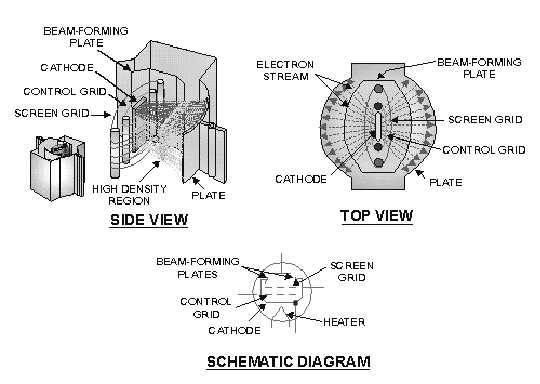2-5
reach the plate. Thus, the tube has the advantage of high power output and high efficiency. An added
advantage to this type of grid arrangement is high-power sensitivity. This means that the tube can respond
to much smaller input signals than the conventional electron tube. The reason for this is obvious; many
more electrons reach the plate from the cathode. Therefore, large plate currents can be obtained from
relatively weak input signals.
Another type of power amplifier tube that is similar to the power pentode is the BEAM POWER
TUBE. Beam power tubes have the same grid arrangement as the power pentodes. In addition, they use a
set of beam-forming plates to force the electron stream into concentrated beams. Figure 2-6 depicts the
internal construction of a beam-forming tube and its schematic representation. Notice that the beam-
forming plates surround the grids and their supporting structures and are internally connected to the
cathode. This internal connection ensures that the beam-forming plates are at the same negative potential
as the cathode. Electrons that are emitted from the sides of the cathode are repelled from the grid supports
and into the electron stream by the negative charge on the beam-forming plates. Electrons pass to the
plate through the spaces between the beam-forming plates and, by doing so, are concentrated into beams.
Because the beam-forming plates are at a negative potential, any electrons emitted by secondary emission
are repelled back to the plate. The effect of the beam-forming plates is to increase the number of electrons
in the electron stream by forcing stray electrons emitted from the sides of the cathode away from the grid
supports and into the electron beam. Electrons that are deflected from the grid wires are also forced into
the beam. This increases the total current flowing to the plate. For this reason, both beam-forming and
power pentodes are suitable for use as power amplifiers.
Figure 2-6.—The beam-power tube.

